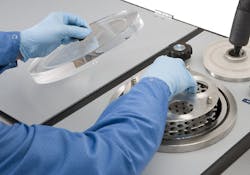A Parylene conformal coating overview
The Dimer
The raw dimer form of Parylene is a granular, white powder described chemically as poly-para-xylylene. There are different variants of the material: the most popular being Parylenes N, C, and D, and the selection of the optimal dimer depends on the demands of each application.
Parylene C has a chlorine atom on the benzene ring, resulting in a useful combination of electrical and physical properties; particularly low moisture and gas permeability.
Parylene N has the highest dielectric strength of the three versions, with a dielectric constant value that is independent of frequency. Parylene N is commonly used in high-frequency applications.
Parylene D has two chlorine atoms added to the benzene ring, giving the deposited film an increased level of thermal stability.
Another common variant is Parylene F, which has a fluorinated atom on the benzene ring and provides advanced thermal and UV properties. This dimer is suited to high temperature coating applications.
The Parylene Coating Process
Parylene film is applied in a gas phase sequence beginning with conversion of the powdered dimer to a monomer gas under heat. The vapor moves to a room-temperature vacuum deposition chamber where it forms on exposed substrate surfaces as a thin, transparent polymer film. This polymerization takes place without the introduction of any catalysts or solvents.
This transparent film coating differs from conventional coatings in that there is no liquid phase,
and physical manifestations common to liquid coatings such as meniscus and the tendency to pool and draw away from corners, are not seen. Since the coating is formed directly from a gas, it does not create cure stresses, and confirms closely to the underlying substrate without bridging between adjacent components. Parylene builds with equal thickness on flat surfaces and corners, edges and in crevices.
Read the related article: Protecting aerospace components: QPL verification is a key in Parylene coating specification
For more information, visit Para Tech Coating Inc.'s website at http://www.parylene.com/.



